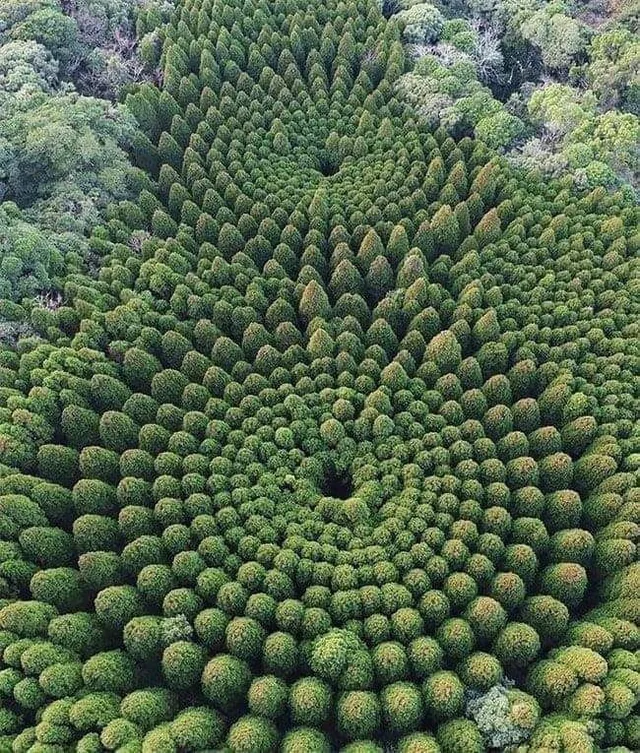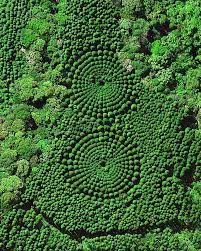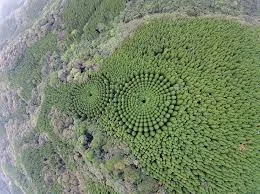In Japan’s Miyazaki Prefecture, a forestry experiment launched in 1973 has blossomed into an unexpected masterpiece of natural design. Near Nichinan City, sugi (Japanese cedar) trees were planted in precise, concentric circles to study the effects of tree spacing on growth. Nearly five decades later, aerial photos and Google Earth imagery reveal a striking, convex forest of swirling patterns, where trees grow taller and denser outward, defying expectations. This unintended phenomenon, dubbed “crop circles” for its otherworldly appearance, showcases nature’s response to human ingenuity and has prompted officials to reconsider harvesting plans, preserving this captivating landscape.

A Bold Experiment in Tree Spacing
In 1973, Japan’s Ministry of Agriculture, Forestry, and Fisheries designated an area near Nichinan, in Miyazaki’s Minami Naka region, for experimental forestry. The goal was to optimize the production of Obi cedar, a local sugi variety (Cryptomeria japonica) historically used for shipbuilding (benko lumber) but shifting toward general timber due to changing market demands. To test how planting density affects growth and wood quality, researchers planted 720 cedar trees in two groups of 10 concentric circles, with each tree spaced at 10-degree radial increments from the center. The circles varied in radius, creating densities gradients from 377 to 10,027 trees per hectare.

The design was methodical: inner circles were tightly packed, while outer ones allowed more space, hypothesizing that less competition for sunlight, water, and nutrients would boost growth. The site, on a forested mountainside, was left to mature, with minimal intervention beyond periodic monitoring.
An Unexpected Natural Spectacle
By the 2010s, aerial photography revealed an astonishing outcome. The forest had grown into two mesmerizing, concave formations, visible as concentric rings swelling upward like green mandalas. The outer trees, benefiting from greater access to resources, stood over 5 meters taller than those in the crowded center, creating a convex, bowl-like shape. This height gradient, an unplanned result, confirmed that tree density profoundly impacts growth, with sparser planting fostering larger, healthier trees.

The patterns, spanning about 70 meters in diameter, caught global attention when photos surfaced online around 2018, sparking comparisons to crop circles and even alien landings. Social media platforms buzzed with images, from Reddit to Instagram, marveling at the “mystery circles.” Google Earth coordinates (31°43’50.3″N, 131°23’04.9″E) allow anyone to view the forest’s hypnotic design, its concentric rings stark against the surrounding wilderness.
Ecological and Cultural Insights
The experiment’s results go beyond aesthetics. The concave growth pattern underscores how competition shapes ecosystems: inner trees, cramped and resource-starved, grew stunted, while outer ones thrived with ample light and nutrients. This supports the hypothesis that sparse planting, as used historically for benko lumber, produces stronger timber, offering lessons for sustainable forestry amid Japan’s monoculture challenges, where sugi dominates 57% of harvested timber.

Culturally, the forest resonates with Japan’s reverence for nature and precision. Sugi, a sacred tree often planted near temples, embodies resilience and utility, yet the experiment’s unintended beauty evokes the wabi-sabi aesthetic—finding perfection in the imperfect. Its viral fame has drawn comparisons to artistic land projects, though its scientific roots ground it in practical inquiry.
A Forest Spared, for Now
Originally slated for harvesting around 2018, the circular forest’s newfound celebrity prompted a rethink. The Japan Forestry Agency, noting its scientific and cultural value, extended the experiment, with some sources suggesting preservation until at least 2023. Whether it will remain standing or be felled for timber is uncertain, but its global appeal—amplified by media like Sankei News and the Associated Press—argues for its legacy as a living laboratory and natural artwork.
A Testament to Curiosity and Nature
Miyazaki’s circular sugi forest is a serendipitous blend of human intent and nature’s artistry. What began as a study of tree spacing has become a global phenomenon, its concentric rings a reminder that even controlled experiments can yield wild beauty. Visible from above, enduring in the digital age, this forest stands as a monument to scientific curiosity and the unpredictable wonders of the natural world.


